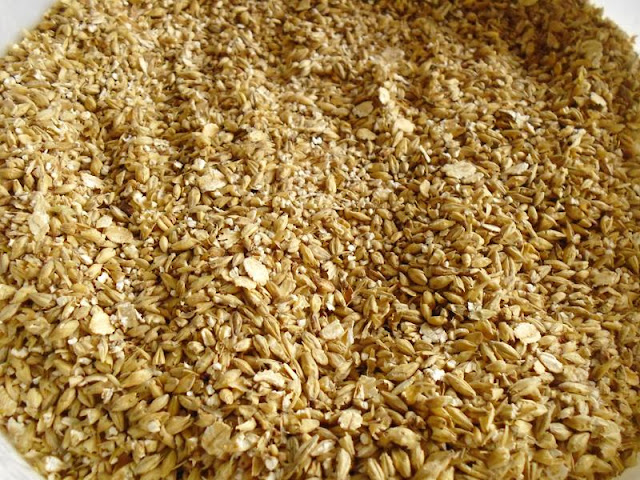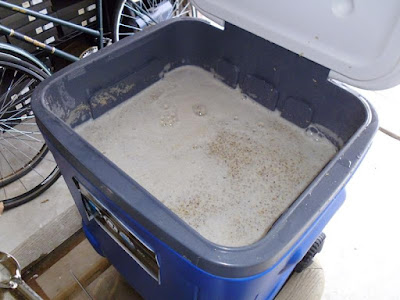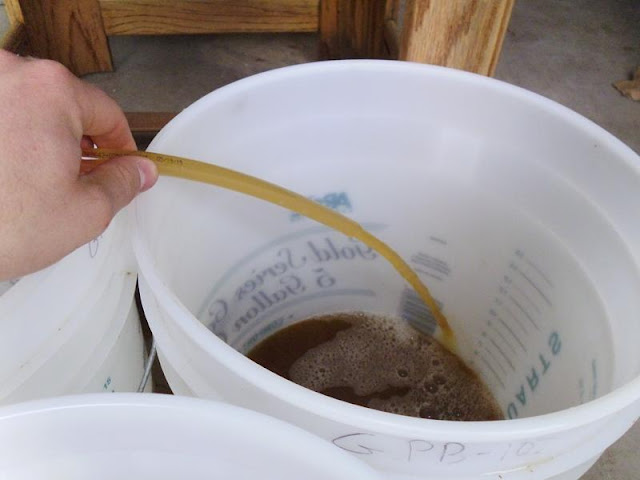 |
| A nice mixture of two row, white wheat, and honey malt. |
I got an idea for a new recipe when I was getting my starter ready for
Ol' 22. I took a taste of the beer I decanted from the saved yeast; it did not taste bad at all. The starter was only a small amount of dried malt extract. So then I thought to myself "why not try making a blonde/honey ale from
WLP023?" From WhiteLab's website, they don't recommend using Burton Ale yeast to make a honey ale. But maybe with the hard water I have in the Sacramento region, it will turn out working.
I looked around to find a mass produced beer to use as an inspiration for the recipe. After looking at 805 by Firestone Walker so many times in the grocery store, I decided to give that one a try. It just so happened to be the flavor I was looking for.
 |
| Heat cycling the mash tun |
I designed my recipe based upon that brief taste test. To get the honey flavor, I would add in honey just prior to the boil. With this in mind, the brew would not need as much two row to achieve the target gravity. However in doing so, my grain bill remained too low to make full use of my new
mash tun.
 |
| Recirculating the get all the valves and fittings heated |
I didn't want to go back to doing
Brew-in-a-bag when I had just broken in my mash tun. Since I really wanted to use it, I thought to myself: Why not double up the grain weight to make twice the volume?
 |
| Mashing in! |
It wouldn't be hard to add in the grain to my mash tun; I had just done a batch using 16 lbs of grain for 5 gallons worth of beer. The problem here would be managing and being able to boil enough wort to end up with two fermenters full of wort once brew day was complete. The easiest way for me to do this with my current setup would be to do two sublots of boiling. I would make ~16 gallons of wort from lautering, and boil 8 gallons at a time with my two 4 gallon kettles.
 |
| A mash as thin as my BIAB batches |
To get 16 gallons of wort, I'd need to start with about 9 gallons of water in my mash tun on brew day and mash in all my grain to that. Once the 90 minute mash completes, sparge with ~8 gallons of water (accounting for the grain) to get my starting boil volume. This is doable in theory, now it was time to prove it.
 |
| Let this sit for 1.5 hours. |
The mash was as thin as some of my BIAB batches, but I doubt that is going to cause any issue. My manifold is setup to prevent any husks from passing through even with an unstable grain bed. While the mash was going, I had to take my kettles back and heat up the sparge water necessary.
 |
| Sparge water ready |
For this setup, instead of lautering directly into my kettles, I would be sending the wort into several buckets. Once there, I'd mix the wort by casually pouring it from one bucket to another, to keep boiling consistent between the two kettles for both sublots.
 |
| Post mash excitement |
 |
| Lautering begins. A nice pale, yellow color. |
It took some patience to ensure that all the wort I wanted to get out of this grain bed was properly mixed. I used the tubing on my valve to divide the outflow as well as I could to ensure even mixing up front. What was left was brute force dumping one bucket into another. An idea I had here was to empty out the mash tun to mix and drain all the wort, but that would have required scooping out all the grain and risked the chance of husks getting into the wort.
 |
| The grain bed begins to settle |
 |
| This is going to be exciting |
 |
| New wort production record |
With lautering complete, it was time to pour the first sublot into the boiling kettles and
start boiling.
While that was happening, I took the time to empty out the grain from the mash tun into a specifically marked container.
 |
| That's a lot of grain |
Many commercial breweries and some homebrewers have their spent grain hauled off to farms where it is fed to livestock. I struck a deal with one of my coworkers to trade him the spent grain from this batch for some eggs from his hens.
 |
| To be used as chicken feed |
These had to be the best eggs I've ever eaten. I'll have to continue this exchange as long as the chickens find the grain tasty. And to think that I have been placing all this spent grain in my green waste bin for all my batches before this one...
 |
| Eggcellent Eggchange! |
















No comments:
Post a Comment
Hi folks, please only leave comments relative to the blog post. All spam will be removed and spammers will be blocked.
Note: Only a member of this blog may post a comment.